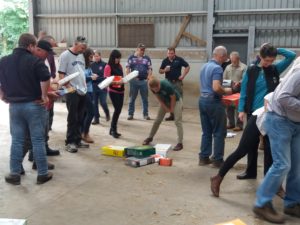Resilience Planning in Your Flock (Brechin) Event Summary
24 July 2018The topic of this meeting was to look into the different areas of the farms sheep enterprises and discuss ways on which we can build resilience into the flock in turn increasing their productivity and efficiency. The meeting was opened up by the host farmer, Graeme Mather, with an introduction to his farm and explanation about how he runs his sheep flock.
 The group then went round three different work station sin the morning which consisted of worming programmes, shelterbelts and agroforestry, and footrot and lameness. The first station was headed up by Heather Stevenson, SAC Consulting vet, who explained the life cycle of the most common worms found in sheep and explained the different worming groups available. The group were than tasked with trying to identify which wormers belonged in which groups purely from the labels and packaging of the wormer. This showed how many different wormers there are available. The group were also asked to calibrate dosing guns this showed that unless done correctly doses administered aren’t always accurate, unless the amount of drugs given is accurate they may in ineffective. Heather stressed the importance of doing faecal egg counts on the sheep before routinely worming to ensure unnecessary treatment doesn’t take place which only helps speed up the process of anthelmintic resistance in worms.
The group then went round three different work station sin the morning which consisted of worming programmes, shelterbelts and agroforestry, and footrot and lameness. The first station was headed up by Heather Stevenson, SAC Consulting vet, who explained the life cycle of the most common worms found in sheep and explained the different worming groups available. The group were than tasked with trying to identify which wormers belonged in which groups purely from the labels and packaging of the wormer. This showed how many different wormers there are available. The group were also asked to calibrate dosing guns this showed that unless done correctly doses administered aren’t always accurate, unless the amount of drugs given is accurate they may in ineffective. Heather stressed the importance of doing faecal egg counts on the sheep before routinely worming to ensure unnecessary treatment doesn’t take place which only helps speed up the process of anthelmintic resistance in worms.
After this we heard from Malcolm Young, an SAC Consulting Woodland specialist, on the benefits of shelterbelts, hedges and trees to not only the environment but as an aid to providing essential cover for sheep in harsh weather conditions. Malcolm highlighted the grants and funding available to the farmers to help with the establishment of woodlands and shelterbelts on farm which provided a lot of discussion and questions from the audience. A copy of Malcolm’s presentation is available below.
Valentina Busin, a researcher from Glasgow University, spoke to the group about footrot and lameness in the flock and ways and means of controlling and treating it. There was a lot of positive discussion on the different causes of lameness and many questions asked on preventative measures that could be taken, whether it be vaccinating or foot bathing. Valentina’s main take home message was that the advice given now in relation to lameness has changed and that we should not be over paring lame ewes to try to investigate and cure lame ewes! They should instead be pared only if necessary to remove overgrown hoof and be treated with antibiotics.
In the afternoon the group had a session with Kirsten Williams and Karen Stewart on the topics of ewe management at weaning and feeding the finishing lamb when there is very little grass currently available due to drought conditions. Karen highlighted the importance of knowing what the energy requirements of the ewe are and feed accordingly. This may require a little extra hard feeding just now to improve condition for tupping as grass is in very short supply. Kirsten then spoke about alternative forages to consider when there is a lack of grass and that crops such as stubble turnips could provide some much needed fodder when grass is short.
Take home messages from the day include;
- When thinking about worming, do not routinely worm! Do faecal egg counts first to check there is a need for it and if there is a need be careful which wormer group is used.
- Shelter belts and providing cover for the flock are important for productivity and there are grants available to aid with this.
- If a ewe is lame and footrot is suspected, do not heavily pare the foot as previously advised.
- Think about alternative forages going forward due to lack of grass, stubble neeps could provide extra winter fodder.
- Using Forestry for Resilience in Sheep Farming
- This is a copy of the presentation Malcolm Young gave at the Brechin meeting in July 2018.
Sign up to the FAS newsletter
Receive updates on news, events and publications from Scotland’s Farm Advisory Service

